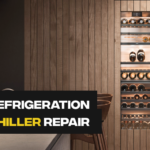Viking Wine Cooler Coolant Leaks
Post Date: June 20, 2024

Viking wine coolers are renowned for their exceptional ability to preserve wine at its optimal temperature, creating an ideal environment for your prized vintages to mature and age gracefully. However, even the most sophisticated appliances can encounter issues, and a coolant leak is a serious problem that can compromise the integrity of your wine collection. This comprehensive guide will delve into the causes of coolant leaks in Viking wine coolers, provide detailed DIY solutions to address the issue, and outline preventive measures to safeguard your appliance from potential leaks.
Causes of Coolant Leaks in Viking Wine Coolers
Coolant leaks in Viking wine coolers can stem from various factors, ranging from manufacturing defects to wear and tear over time. Here are some of the common causes:
-
Damaged Coils: The evaporator and condenser coils, which are integral components of the cooling system, are susceptible to damage from corrosion, physical impact, or excessive pressure. Leaks can occur at cracks, punctures, or weak spots in these coils.
-
Faulty Seals and Connections: The seals and connections that join various components within the cooling system can deteriorate over time, leading to leaks. This is particularly common in older wine coolers or those that have been subjected to extreme temperature fluctuations or excessive humidity.
-
Loose Components: Over time, vibrations or improper installation can cause nuts, bolts, and fittings within the cooling system to loosen, creating pathways for coolant to escape.
-
Manufacturing Defects: In rare instances, manufacturing defects can result in faulty components or improper assembly, leading to coolant leaks from the outset.
DIY Solutions for Coolant Leaks in Viking Wine Coolers
Before calling a professional technician, there are a few DIY solutions you can attempt to identify and address a coolant leak in your Viking wine cooler. However, it’s crucial to proceed with caution, as coolant leaks can pose health and safety hazards.
-
Visual Inspection: Disconnect the wine cooler from power and carefully inspect the exterior for any visible signs of coolant leaks. Look for stains, puddles, or oily residues around the base, coils, or connections.
-
Leak Detection Dye: Purchase a refrigerant leak detection dye kit from a hardware store. Inject the dye into the cooling system according to the instructions. Allow the system to run for a period, then use a black light to inspect for fluorescent dye trails, indicating leak points.
-
Bubble Test: If the leak is small and difficult to pinpoint, you can perform a bubble test. Mix a solution of soapy water and apply it to suspected leak areas. If bubbles appear, you’ve identified the leak source.
-
Temporary Sealant (Not a Permanent Fix): For minor leaks, you can use a specialized refrigerant sealant to temporarily seal the leak. However, this is not a permanent solution and should only be used as a last resort until professional repair can be obtained.
Preventive Measures to Safeguard Your Viking Wine Cooler
To minimize the risk of coolant leaks in your Viking wine cooler, follow these preventive measures:
-
Regular Maintenance: Schedule regular professional maintenance checkups for your wine cooler. A qualified technician can inspect the cooling system for signs of wear, loose components, or potential leaks.
-
Handle with Care: Avoid bumping, jostling, or excessively moving the wine cooler, as this can damage internal components and increase the risk of leaks.
-
Monitor Temperature and Humidity: Maintain a stable temperature and humidity level within the wine cooler’s environment. Extreme fluctuations can stress the cooling system and contribute to leaks.
-
Prompt Leak Detection: Address any suspected leaks promptly. Delaying repairs can worsen the issue and potentially damage the wine cooler beyond repair.
Conclusion
Coolant leaks in Viking wine coolers can pose a serious threat to your wine collection and the overall health of your appliance. By understanding the causes, implementing DIY solutions with caution, and following preventive measures, you can effectively address potential leaks and safeguard your Viking wine cooler for years of reliable performance. Remember, if you encounter a coolant leak or are unsure about any DIY troubleshooting step, always prioritize safety and seek professional assistance from a qualified technician.








